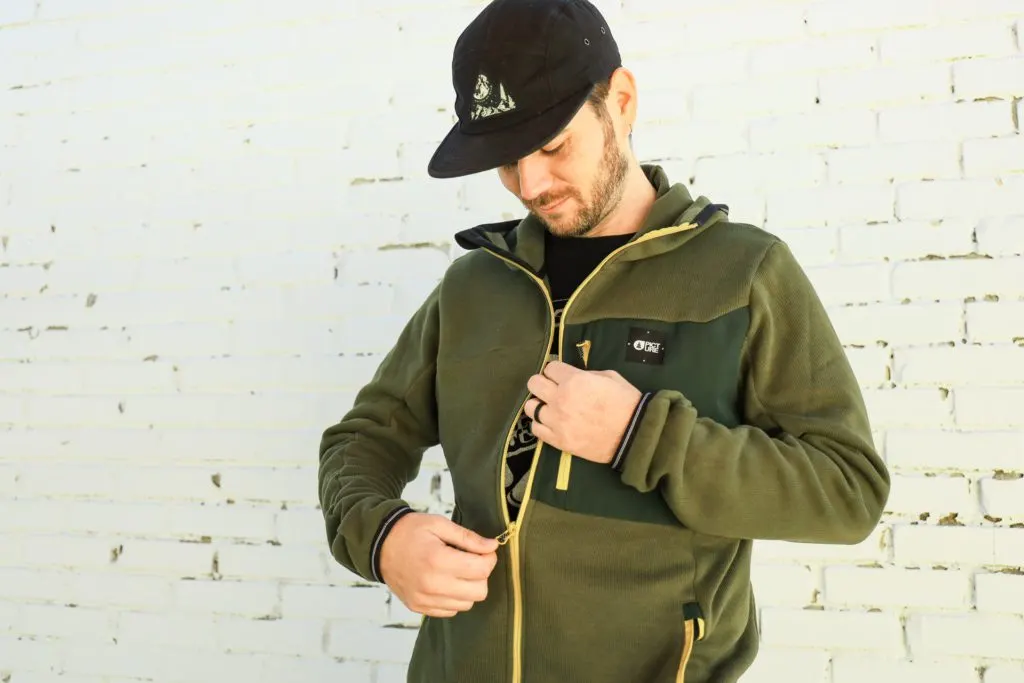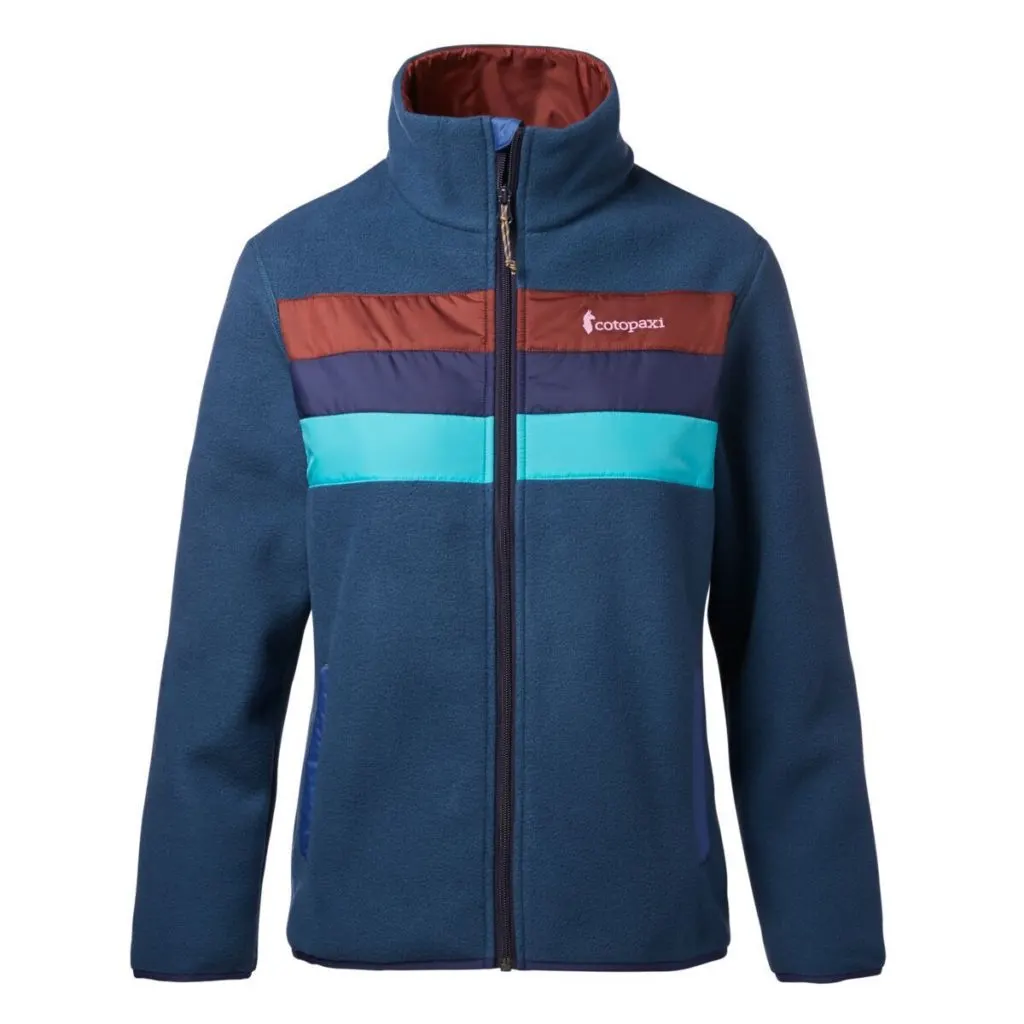REI Anniversary Sale May 16-26 - Up to 30% off plus 20% off member deals!

Fleece. It’s everybody’s favorite outdoorsy (and pseudo outdoorsy) material. We love our fleece blankets and zip-ups and sleeping bag liners for how cozy and cuddly and water resistant they are. Fleece hoodies and jackets and gloves are an outdoor staple because they wick sweat and are breathable and fast-drying. But since fleece is typically made out of PET (a type of plastic), and studies show it contributes to micro plastics in our waterways, is fleece all it’s cracked up to be? And is there such a thing as sustainable fleece?
We’ve been doing some digging, because we freaking love our fleece gear just as much as the next guy, and we do our fair share of drooling over the new fleece products that are released every year (looking at you, Cotopaxi and Patagonia), but we want to make earth-friendly decisions when we stock our gear closet (and our closet-closet). So let’s discuss all things synthetic, microplastics, and sustainable fleece.

What is Microplastic?
First things first: what even are microplastics? Unless you’ve been living in a cave for the last five years (no judgement–kinda wish I was living in a cave for all of 2020), you’ve likely heard the term. But what does it mean, exactly? Basically, they are teeny tiny plastic particles and threads that are too small to be captured by filters and end up in public waterways (rivers, lakes, oceans, you name it).
In fact, one study found that during laundering, a single fleece jacket sheds as many as 250,000 synthetic fibers and water treatment plants can only filter out about 60% of those. In an article in Outside, it was estimated that laundering 100,000 Patagonia jackets each year results in 11,900 grocery bags worth of fibers being released into public waterways. That’s a lot of plastic. But how big of a deal can plastics that small be?
Well, when plastic particles make it into waterways, fish and bivalves and other ocean life inadvertently swallow them, which causes health problems and behavioral changes that could potentially cause a domino effect across entire underwater ecosystems and even effect the people eating them (eww, as vegans, we never recommend eating sea creatures).
There haven’t been a lot of conclusive studies done on how ingesting micro plastics affects humans, but you can bet that at the very least, it’s not great for you. Plastic, after all, is made from petroleum. Then you have to take into consideration any chemical treatments (like waterproof coatings) that may also accompany the fibers to waterways and be ingested by aquatic life (and people). Basically, we’re not trying to scare everybody with unverified info, but the truth is, microplastics are a relatively new problem and we just haven’t had time to document any long-term effects. That said, anything man-made that pollutes nature should raise suspicion.

What About Fleece Made of Recycled Plastic Bottles?
Lots of brands, from Patagonia to Picture Organic Clothing, are making fleece out of recycled plastic bottles these days. This saves a lot of resources: not only does it help address the waste problem we have with single-use plastics, what with experts saying there will be more trash in the ocean than fish by 2050 if we don’t make some big changes soon, but it also means virgin petroleum doesn’t need to be collected and manufactured into fibers for fleece or synthetic insulation. And that’s all good.
However, where microplasics are concerned, studies show that apparel made with recycled plastic bottles sheds just as many fibers as synthetics made of virgin materials. And as it turns out, the age of a fleece garment may also have something to do with how many microplastics are shed. Patagonia did their very own study and found that there was up to an 80% increase in fiber breakage in older garments, so while it’s usually a good idea to hold onto clothing as long as you can and buy used instead of new, in the case of fleece, that may be a trickier debate (buying a new fleece requires new materials and energy for manufacturing and transportation, etc., but keeping older garments out of landfills could be increasing microplastic pollution…).
So Should You Switch to Wool?
We say no, but because we’re vegan. Yes, wool is a natural fiber so microplastics aren’t an issue, but as we wrote about in this post (Say no to Wool), wool is often an inhumane (and unsustainable) textile that involves a lot of cruelty. Plus, animal farming is a huge contributor to climate change. So while it may be easy to argue that because it’s a “natural” material it’s less harmful to the environment, the issue is a lot more complicated than that, unfortunately (and involves a lot of cruelty to animals, which we never endorse). But it’s up to you to decide because sustainability is a spectrum; it’s not black and white.

What to do About It
As of right now, there are plenty of companies and organizations working toward long-term solutions to reduce microplastics (ranging from simple washing machine filters to designing more resilient fibers to costly water treatment plant filters), but for us normal folks who already have closets full of synthetic clothing and gear, what can be done?
It starts in the wash, but should extend to our lifestyles and buying practices as well.
- Use a front-loader: Most scientists researching the issue suggest starting by using energy-efficient front-loading washers. Why? Top-loading washing machines cause more fiber breakage because they more aggressively agitate clothes and thus cause more microplastic pollution than front-loading machines, so when it’s time to upgrade your washer, go with a high-efficiency model.
- Wash cold: Then, wash all your clothes with cold water instead of hot and use liquid detergent and even fabric softener if you can (natural, earth-friendly ones, of course). And wash rough, heavy clothing like jeans separately from soft items like polyester and nylon.
- Utilize tools: Avoid those balls that claim to attract broken fibers; some studies suggest they do more harm than good. But one product that can help: the Guppyfriend laundry bag. The brand will tell you straight up that this bag is not a solution, but it’s a helpful tool. It’s not going to eliminate plastic waste on its own, but it can help reduce it at an individual consumer level, so you should totally get one. We use one and were extremely surprised by how many fibers the bag captured after just one load of a handful of synthetic items!
- Wash less often: Also, just wash your synthetic clothing less. Chances are, your jacket with synthetic insulation and your fleece zip-up and your polyester pants don’t need washed every time you wear them. Just give ’em the ol’ smell test. If inhaling burns the inside of your nostrils, I guess it’s time to wash.
- Buy high quality: High-quality fleece seems to shed fewer fibers when it’s new than cheaply made alternatives (the numbers appear to even out as items age), so if you are going to purchase synthetic clothing, opt for items from responsible manufacturers that are using the highest quality materials possible. Don’t think you can afford that stuff? We don’t blame you; it can be expensive! In that case, try to locate gently used synthetic clothing. We wrote a whole post about buying used gear here.
- Buy fewer synthetics: Lastly, consider the fact that you might not always need synthetic clothing. If you’re hiking in the summer in drier climates, just wear organic cotton. Layer up for casual hikes in the fall with hemp jackets. And when you do need to don the synthetics (like on long backpacking trips or winter excursions in the outdoors), take care of your synthetics.

More Sustainable Fleece Options
We all know we outdoorists aren’t ditching fleece any time soon, so if you do want a new zip-up or hoodie, try these more sustainable fleece options on for size. All use Bluesign materials or are made with recycled materials.
- Coalatree Evolution Hoodie and Joggers
- Patagonia Better Sweater
- REI Hyperaxis Clothing
- Cotopaxi Teca Fleece for women and men (uses repurposed materials)
- The North Face TKA Glacier lineup
The Bottom Line
Synthetic materials are a necessity in the outdoors, but they also do their fair share of damage to the planet. So when you gear up in fleece and other synthetics, shop responsibly, wash infrequently (and use a GuppyFriend wash bag when you do), take good care of your gear, and then get out there and wander on!
•
This post contains affiliate links, which means when you click and make a purchase, we may receive a small percentage of the sale. And that helps keep the lights on and sustainable content comin’ here at Terradrift!

Liz Armstrong
Friday 26th of April 2024
A more recent development is that you can absorb microplastics through your skin when you sweat. I'm now trying to sleuth around to find hiking and workout clothing that is natural.
Alisha McDarris
Monday 29th of April 2024
Natural fiber clothing for hiking does exist! Wool is one (though we don't wear wool because we're vegan), as is bamboo. Cotton, hemp and bamboo are better for warm temps as they don't dry quickly (which means they may chafe on longer excursions). They're not good for colder temps as the slow dry time can result in hypothermia. We've written posts about all these fibers if you're interested!
Juliana Janot
Monday 22nd of April 2024
I'm going to buy that guppyfriend bag. But I was wondering, why nobody invented a laundry machine that has a filter to microplastics yet (to not let release them in the pipes/drain)? Are microplastics too small for any filter to catch them?
Alisha McDarris
Tuesday 23rd of April 2024
I think I recently saw something about machines like that currently being researched or designed! Maybe in Europe? There are after-market filters you can add on to your current machine, though!
Juliana Janot
Monday 22nd of April 2024
Thank you, that is so helpful!
Alisha McDarris
Tuesday 23rd of April 2024
Absolutely! We try to be a solid source of helpful and solutions-based info!
Teresa Willis
Monday 9th of November 2020
Thank you for your thoughtful reply. I need to check into that filter.
Teresa Willis
Thursday 5th of November 2020
Thanks for the information. It's pretty tough to do anything these days without some consequence to the earth.
I followed the link to say no to wool- I did not know any of that about the wool industry. It's interesting that you say no to wool because of the cruelty to animals but give a pass to fleece that is affecting the health of sea creatures. I hope we figure out how to keep micro plastics out of the water ways.
Alisha McDarris
Thursday 5th of November 2020
You're totally right: almost everything we do has some sort of negative impact on the environment. But the concept we like to promote when it comes to sustainability is to do your best whenever and wherever you can to help mitigate those impacts. And when it comes to wool vs synthetics and fleece, it's sort of a lesser-of-two-evils scenario: we choose synthetics because their effects aren't as cruel and they impact climate change to a lesser degree (when compared to factory farming). Plus, there are ways to ease the microplastic problem when using synthetics (those tips for washing really work!). The only way to reduce the negative impacts of the wool industry is to stop using it altogether! And we're so glad you learned something from the wool post! We try to be helpful and informative in addition to snarky and fun. ;-) And agreed: I hope better minds than ours come up with a solution to keep plastics out of our oceans sooner rather than later!